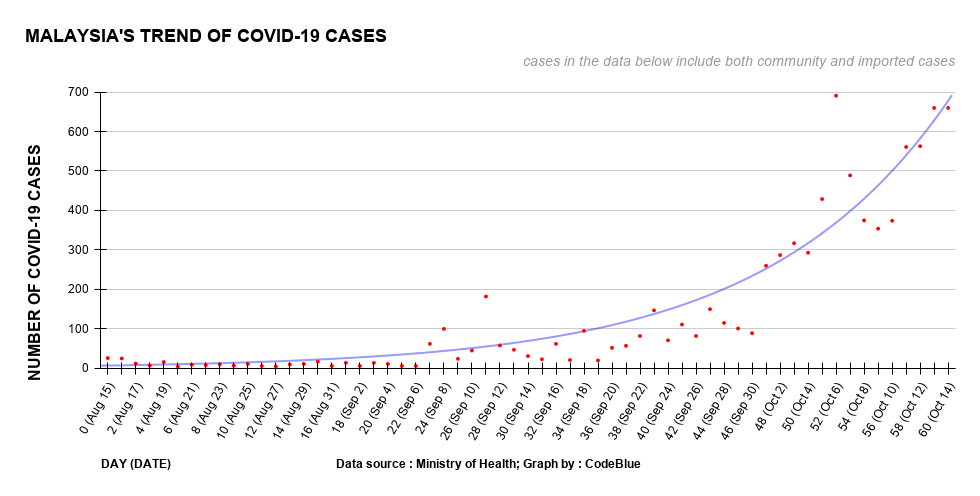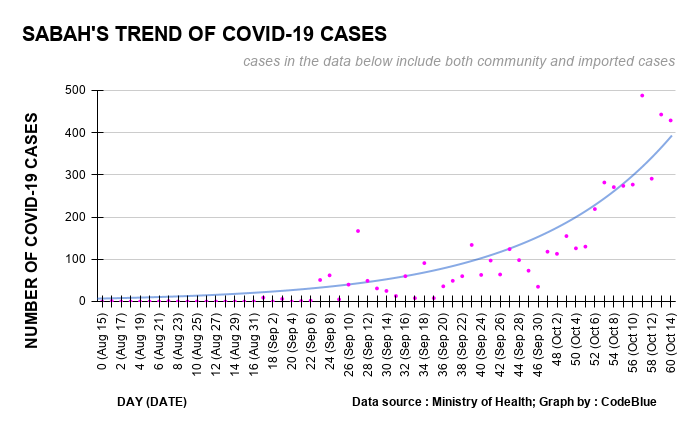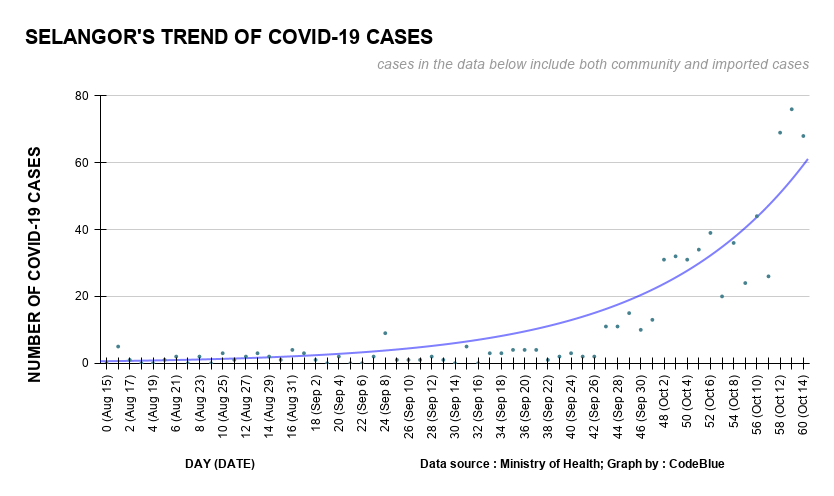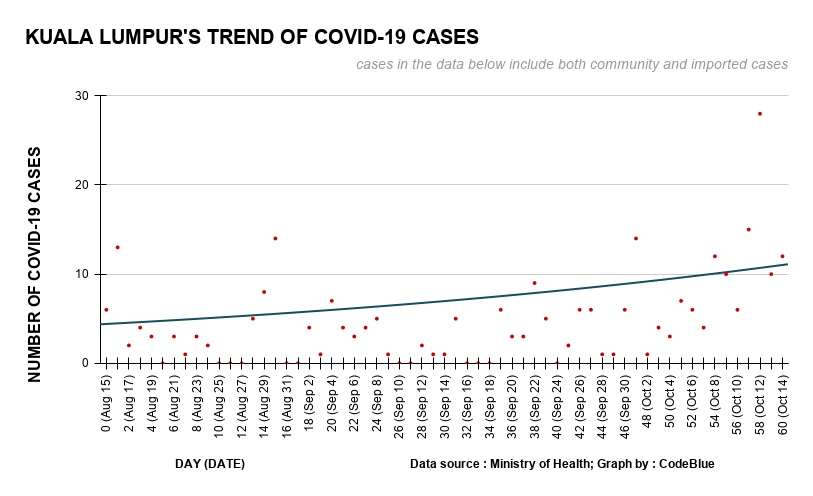KUALA LUMPUR, Oct 16 — Malaysia’s daily new Covid-19 cases are doubling almost every five days on average since early September and further accelerating this month, marking a faster growth of reported infections.
In August, coronavirus cases nationwide took more than a month to double, but things changed from September 7 onwards, when nationwide Covid-19 cases, including imported infections, started doubling within four to 11 days.
The doubling rate of new Covid-19 cases in Malaysia sped up at the tail-end of the Sabah state election that concluded on September 26, with daily infections doubling about every three days, except for a drop in the number of nationwide cases between October 6, with a record high of 691 new Covid-19 cases, and October 9 with 354 cases.

The graph above shows the epidemiological curve of the trend of Covid-19 cases in Sabah, Selangor, Kedah, Kuala Lumpur, and Malaysia as a whole. The epidemiological curves for all were almost flat from August 15 until towards the beginning of September, when the epidemiological curve of Malaysia, Sabah, and Kedah started rising.
Kuala Lumpur maintained a flat epidemiological curve from mid-August until October 15 despite the exponential increase in the nation’s Covid-19 cases. Selangor’s epidemiological curve was maintained close to Kuala Lumpur, and did not rise as much as Kedah or Sabah.
Despite the almost flat epidemiological curve in Selangor and Kuala Lumpur, the federal government implemented a two-week Conditional Movement Control Order (CMCO) on the entire Klang Valley, the country’s economic centre, from October 14 to 27 in Selangor, the capital city of Kuala Lumpur, and the administrative centre of Putrajaya, claiming that strict movement restrictions were necessary to “pre-empt” a spread of infection.

Doubling time is how many days it takes for the number of Covid-19 cases or deaths to double. The shorter the time frame for cases to double, the steeper the epidemiological curve, and the faster the growth of cases. When the doubling time is longer, the curve gets flattened, which means that health care capacity will not be overwhelmed with a surge of Covid-19 cases.
According to NPR, when coronavirus cases take a shorter period of time to double, there will be a massive effect on the health care system as many patients will be flooding into hospitals at about the same time. If the doubling time can be slowed, there will be enough hospital beds to handle incoming Covid-19 cases that are more spread out across a longer period of time.
It is unclear yet if the shorter doubling time of new Covid-19 cases nationwide will strain Malaysia’s public health care system. In the Klang Valley at least — which hosts the country’s main Covid-19 hospital, besides other major hospitals — the epidemiological curve is relatively flat compared to the nationwide and Sabah curves. Sabah faces the additional burden of a large 43 per cent proportion of Covid-19 patients requiring hospitalisation due to serious disease, as hospital beds rapidly fill up amid a shortage of health care workers.
The time that Covid-19 cases take to double was calculated based on the mean number of days that cases were taking to double from September 7 till October 14. On some days, there will be a drop in the number of cases but following that, a few days later, that value will double again. Those number of days were also included in the calculations. This is a simplistic analysis by CodeBlue measuring two months of data between mid-August and mid-October to compare the growth rate of Covid-19 cases before and after the Sabah state election, amid Malaysia’s third coronavirus wave.
What Changed After September 7?
On August 5, the Ministry of Health (MOH) reported 21 new Covid-19 cases nationwide. The total number of cases did not double until September 7, which was 33 days later, recording 62 cases. Since September 7, MOH reported a total of 62 positive Covid-19 cases, which then almost tripled within four days to 182 cases on September 11.
Out of the 62 cases reported on September 7, a total of 80.6 per cent (50) of the cases were from the Benteng LD cluster in Sabah. This cluster was first reported on September 1 among two illegal immigrant detainees at the Lahad Datu police lockup. Then, on September 3, another detainee from Tawau prison was detected positive with Covid-19. This patient had close contact with one of the index cases of the Benteng LD cluster at the Lahad Datu lockup. So, this cluster then spread to Tawau prison.
On September 7, two out of the 50 cases from the Benteng LD cluster reported involved a family member and staff of the prison. Among the 182 coronavirus cases reported in Malaysia on September 11, a total of 167 cases were from this cluster, which means that in the beginning of September, the rise in the number of cases reported in Malaysia were due to the Benteng LD cluster that was initially contained in the prison.
However, on September 11, two cases from this cluster were reported within the general public. This means that the cluster had spread to the community.
September 12 was the beginning of Sabah’s state elections. Although polling day was on September 26, in the two weeks, politicians and canvassers were travelling up and down from peninsular Malaysia and Sarawak to Sabah to campaign. Politicians, during their campaigns, were seen in pictures often without masks or social distancing.
Between September 12 and September 26, MOH reported seven new clusters in Sabah alone. On September 12, the cases reported nationwide were 58 in total, but the numbers more than doubled within 11 days to 147 cases on September 23.
Although 91 per cent of the cases reported on September 23 were from Sabah, four unlinked cases were reported in Selangor, Kuala Lumpur, and Kelantan, whereby these individuals either returned from Sabah or had close contact with someone who returned from Sabah.
This shows that during the middle of the month of September, as cases were spreading within the community in Sabah, there were sporadic cases reported back in peninsular Malaysia, whereby some had a history of travel to Sabah.
On September 24, there were 71 coronavirus cases reported in Malaysia. The cases doubled within three days to 150 cases on September 27. Majority of those cases were reported in Sabah (124 cases), but it is important to note that 15 cases (57.6 per cent) of the cases reported in peninsular Malaysia and Sarawak involved individuals who returned from Sabah.

Prior to September 26, Senior Defence Minister Ismail Sabri Yaakob said that all individuals who were returning from Sabah did not have to undergo quarantine while those symptomatic and returning from areas like Tawau and Lahad Datu (red zones) were only encouraged to be screened for their own safety.
From September 27 onwards, the Covid-19 cases reported nationwide doubled within three days to 317 cases on October 3, which then took three days for the cases to double to 691 cases reported on October 6.
The daily tally pattern of Covid-19 cases across Malaysia was not consistently increasing, but on several days when the cases dropped, infections would double again a few days later.
For example, on October 6, MOH reported 691 coronavirus cases nationwide. Daily new Covid-19 cases dropped in the next few days, as MOH recorded 489 cases on October 7, dipping to 375 cases on October 8, and 354 cases on October 9, but this value almost doubled four days later on October 13 when 660 cases were reported. This means that towards the end of September after Sabah’s state elections, the number of Covid-19 cases across Malaysia rose drastically.
From September 22 to October 13, a total of 394 individuals who tested positive for Covid-19 were Sabah returnees, while 23 clusters had index cases with a travel history to Sabah.
Since the government had announced that all Sabah returnees will have to undergo a mandatory screening at airports upon arrival from September 27, MOH had increased their daily testing rates as compared to August.
In August, although the time taken for cases to double was long, the total number of daily RT-PCR tests that MOH conducted nationwide to detect Covid-19 were between 5,000 and 6,000 tests only, according to deputy health minister, Aaron Ago Dagang. It could be a possibility that because of the fewer number of tests being conducted, fewer cases were detected, hence the doubling time was longer.
Testing Rates Doubled On October 1 From September 1
On September 1, only 6,161 RT-PCR tests were conducted, but on October 1, a total of 13,459 tests were conducted, which is 2.1 times more than that of September 1, which is when MOH started reporting new three-digit cases consistently. However, it is to be noted that the daily testing rates are different every day.
MOH has a maximum testing capacity of 41,254 tests a day and on October 7, MOH managed to utilise its testing capacity by 51 per cent. However, on October 12, MOH reported only 34 per cent of its RT-PCR testing capacity was used, amid the consistent daily three-digit cases being reported.
Sabah: Covid-19 Cases Double Quicker After Election
The doubling time for daily new Covid-19 cases in Sabah slowed during the Sabah state election campaign that was held from September 12 to 26, compared to the first half of the month, though still faster than August. However, after the tail-end of the polls, the doubling rate of new infections picked up speed.
In August, Covid-19 cases in Sabah took a longer period of time, almost a month, to double, as compared in September and October. On August 6, MOH reported four cases in Sabah, which only doubled after 26 days on September 1 (nine cases). Between these two dates, the daily cases reported in Sabah were below four and most times, it was zero.
From September 1, Sabah then started reporting Covid-19 cases continuously every day till October 13, and cases were doubling within a very short period of time. On September 1, MOH reported nine cases, and within six days on September 7, coronavirus cases multiplied by almost a factor of six to 51 cases.
From September 7 till September 11, within four days, daily Covid-19 infections in Sabah tripled from 51 cases to 167 cases.

The number of cases reported in Sabah dropped on September 12, with a two-digit number (49 cases), but in 11 days, throughout the state election campaign, Covid-19 cases in Sabah tripled to 134 cases on September 23.
Covid-19 cases in Sabah then dropped to 63 cases on September 24, but the number doubled in just three days with 124 cases reported on September 27. Following that, daily Covid-19 cases once again dropped to 98 cases on September 28. In eight days, Sabah’s coronavirus cases doubled to 219 cases on October 6 and five days later, the cases doubled again to 488 cases on October 11.
Cases have not doubled in Sabah since then, but three-digit daily tallies have still been consistent.
Selangor: Covid-19 Cases Double Faster In October Than August To End September
According to MOH data of Covid-19 cases reported in August in Selangor, the cases took almost two months to double. Six cases were reported on August 1, and these numbers only doubled to 11 cases after 57 days on September 27, immediately after Sabahans went to the polls on September 26.
Among the 11 cases reported on September 27, eight cases were individuals who had a history of travel to Sabah.

Covid-19 cases in Selangor almost tripled from 11 cases on September 27 to 31 cases to October 2. This only took five days. Among the 31 cases, 41.9 per cent (13 cases) were individuals with travel history to Sabah.
They had travelled to Sabah before Covid-19 screenings at airports were made mandatory. MOH also reported a new cluster on October 2, Anggerik cluster, whereby the index case also had a history of travel to Sabah.
From October 2 to October 12, cases took 10 days to double from 31 cases to 69 cases.
KL: Covid-19 Cases Yet To Double Since August
On August 5, MOH reported 15 new Covid-19 cases in Kuala Lumpur. Since then, the daily number of infections has remained below 30 cases; the highest was recorded on October 12, with 28 cases.
Out of the 28 cases reported, the majority of the coronavirus cases were from three clusters: Baiduri (10 cases), Bah Perdana (eight cases), and Bah Kasturi cluster (four cases). The index cases of Bah Perdana and Bah Kasturi clusters have both had travel history to Sabah.

The government has implemented a conditional movement control order in the whole of Klang Valley, including Kuala Lumpur, from October 14 till October 27. Health director-general Dr Noor Hisham Abdullah said this action was taken to prevent the coronavirus infection from spreading across districts or states, although the World Health Organization (WHO) has warned countries from using lockdowns to contain the virus as it could dramatically impact poverty.
Kedah: Covid-19 Cases Double In Four Days Early October
In Kedah, on August 2, Kedah reported 11 new Covid-19 cases. Over a month later (37 days), cases doubled to 22 on September 8.
Coronavirus cases then rose more than double the number in 23 days on October 1, reporting 98 cases, out of which 88 were from the Tembok cluster in a prison in Kedah.
Four days later, the cases more than doubled to 241 cases on October 5, with 241 positive cases. Since then, Kedah’s reported cases have not doubled, but the state recorded 397 cases on October 6.








